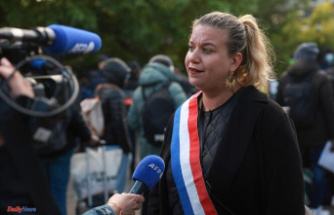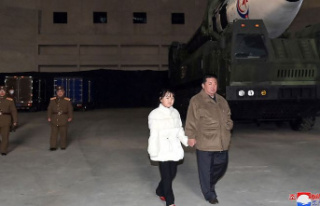After the successful counter-offensives in the Kharkiv and Cherson regions, the Ukrainian general staff is faced with a tricky decision. Should one drive a wedge between the Russian armed forces with a risky large-scale attack in the south, or should one rather annihilate Moscow's demoralized formations in smaller battles of attrition?
The Russian Ministry of Defense reported on Friday that the village of Opytne, just a few kilometers north of the city of Donetsk, had been taken. Since the front has been running there since 2014, the positions on both sides are well developed, and the gains in terrain are correspondingly small and associated with high losses.
Nevertheless, the Russian side is also trying to seize the initiative elsewhere in the Donetsk region. Kremlin chief Vladimir Putin only allowed his commander in Ukraine, General Sergey Surovikin, to withdraw from Cherson behind the Dnipro River on the condition that he conquer the entire Donetsk region in eastern Ukraine in return, experts at the US think tank Institute suspect for the Study of War (ISW).
Some of the forces released by the withdrawal from Cherson have already been hastily transferred to eastern Ukraine in order to intensify the attacks there. In addition to the fighting in front of Donetsk, the Russians are also trying to break through the defenses around the conurbation between Slowjansk and Kramatorsk in the north near the small town of Bakhmut. In the south they want to roll up the front near Wuhledar.
There they may have only achieved a Pyrrhic victory by taking the village of Pavliwka. The village lies in the valley and can easily be bombarded by artillery from the higher positions near Wuhledar. The Russian field commander Alexander Chodakowski complained about high casualties and called the offensive premature.
But Moscow is probably interested in tying down Ukrainian defense forces and imposing its type of warfare on Kyiv. This is aimed at wearing down the enemy - as happened for months in the Donbass with the destructive fury of the Russian artillery. The Russian rocket attacks, which paralyze the country's energy supply, are probably intended as a flanking measure to make the population war-weary.
According to reports, there is still a mood of crisis in circles close to the Kremlin: "The realization that we have lost the real war has come," the Internet portal "Meduza" quotes anonymously from business circles. The momentum is clearly on the side of the Ukrainian army. According to calculations by military observers, they have now recaptured more than 50 percent of the territory that Russia occupied after the February 24 invasion.
The Ukrainian general staff led by Commander-in-Chief Valeriy Saluschnyj is now faced with the question of which weak point of the Russian troops he will attack next. However, Kyiv can no longer count on the element of surprise from late summer, when the Russian military leadership badly underestimated the Ukrainian one and did not trust it to carry out more complex offensive operations.
If the Ukrainian leadership were to seek a decisive battle, the most likely direction would be a push in the Zaporizhia region south towards the Sea of Azov. With advances between the small town of Tokmak and the transport hub of Polohy all the way to the port city of Berdyansk, Kyiv could drive a wedge between Russian troops stationed in southern Ukraine. The land corridor to the Crimean Peninsula, annexed in 2014, would be disrupted.
The Ukrainian army does not have to advance all the way to the coast with its precise, long-range artillery. A front shift of a good 20 kilometers to the south would be sufficient to gain fire control down to the coast. This could massively disrupt the Russian supply lines that lead from Donbass and Crimea to the occupied parts of the Cherson and Zaporizhia regions.
General Staff Spokesman Oleksiy Hromov has already assured that Ukrainian artillery controls the land approaches to Crimea from their positions on the Dnipro. "The Ukrainian artillerymen are doing everything possible to hit the enemy with the maximum range of their weapons," said Hromov. As in the north-western part of the Cherson region, the Ukrainian troops could slowly but surely bring the Russian occupiers into a position through constant shelling and a persistent increase in pressure that would force them to withdraw again.
Preparations for such an attack are underway: Russian observers estimate that up to 40,000 Ukrainian soldiers have already been deployed to the Zaporizhia region - some even from Cherson, where the troops are no longer needed. However, this decisive battle also entails enormous risks for the Ukrainians. The Russian military is aware of the strategic importance of Zaporizhia and has also prepared. Troops were reinforced - also through partial mobilization - for the first time in this war the Russians also dug heavy defensive positions.
The steppe landscape that prevails there allows rapid action in good weather, which is important for Kiev's dynamic warfare. At the same time, however, it offers little protection to attacking troops, so that they can be engaged by artillery at long range. In addition, autumn and winter now bring rain, snow, and fog, turning the area into a muddy landscape and hampering fast offensive movements.
The US military is therefore skeptical that a quick knockout succeed. "The likelihood of a Ukrainian military victory, defined as kicking the Russians out of all of Ukraine, including their claimed Crimea (...), is not high in the foreseeable future," said US Chief of Staff Mark Milley. Therefore, Kyiv could also rely on waiting and pin-prick attacks to tire the opponent. Due to the shorter distances between the individual front sections in the north and south, the Ukrainians have an advantage when it comes to troop movements.
In the north-east, where the Ukrainians took almost all of the Kharkiv region in September, the offensive east of Kupyansk has come to a standstill. With fresh forces from Cherson, territory gains could also be achieved here, even if they are not of strategic importance. In this case, however, the psychological effect would be important, because the morale of the Russian troops was hit after the retreat. Further defeats could accelerate the decomposition process.












